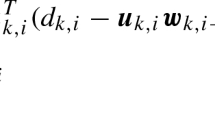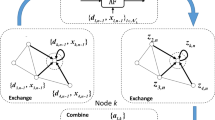Abstract
The paper proposes a smart method to remove network nodes that are highly prone to impulse noise and replacing them with a linear combination of existing more reliable nodes. This is done to reduce communication cost. To reduce the communication cost in a network, a common way is to remove some nodes randomly and then replace the intermediate estimation of these nodes by the corresponding node estimation. In this direction, the contribution of this paper is twofold. First, we suggest to remove the nodes smartly by omitting the unreliable nodes prone to impulsive noise. This is done by computing the disturbance induced in the adaptation step of the diffusion least mean square. Second, we replace the estimation of removing nodes by a linear combination of existing estimations of reliable nodes instead of just replacing by the estimation of the corresponding node. Also, the coefficients of linear combination are optimized based on the minimum disturbance principle. Furthermore, the minimum achievable disturbance is calculated mathematically and a necessary and sufficient condition for stability of the proposed algorithm is presented. Finally, the simulation results show the efficiency of the proposed method in comparison with some state-of-the-art algorithms.




Similar content being viewed by others
References
S. Al-Sayed, A.M. Zoubir, A.H. Sayed, Robust distributed estimation by networked agents. IEEE Trans. Signal Proc. 65(15), 3909–3921 (2017)
R. Arablouei, S. Werner, Y. Huang, K. Dogancay, Distributed least mean-square estimation with partial diffusion. IEEE Trans. Signal Process. 62(2), 472–484 (2014)
R. Arablouei, K. Dogancay, S. Werner, Y. Huang, Adaptive distributed estimation based on recursive least-squares and partial diffusion. IEEE Trans. Signal Process. 62(14), 3510–3522 (2014)
R. Arablouei, S. Werner, K. Dogancay, Y. Huang, Analysis of a reduced-communication diffusion LMS algorithm. Signal Process. 117, 355–361 (2015)
S. Ashkezari-Toussi, H. Sadoghi-Yazdi, Robust diffusion LMS over adaptive networks. Signal Process. 158, 201–209 (2019)
F.S. Cattivelli, A.H. Sayed, Diffusion LMS strategies for distributed estimation. IEEE Trans. Signal Proc. 58, 1035–1048 (2010)
H. Chang, W. Li, Correction-based diffusion LMS algorithms for secure distributed estimation under attacks. Digital Signal Process. 102, 102735 (2020)
H. Chang, W. Li, Correction-based diffusion LMS algorithms for distributed estimation. Circuit Syst. Signal Process. 39, 4136–4154 (2020)
F. Chen, X. Shao, Broken-motifs diffusion LMS algorithm for reducing communication load. Signal Process. 133, 213–218 (2017)
F. Chen, S. Deng, Y. Hua, S. Duan, L. Wang, J. Wu, Communication-reducing algorithm of distributed least mean square algorithm with neighbor-partial diffusion. Circuit Syst. Signal Process. 39, 4416–4435 (2020)
S. Chouvardas, K. Slavakis, S. Theodoridis, Trading off complexity with communication costs in distributed adaptive learning via Krylov subspaces for dimensionality reduction. IEEE J. Sel. Top. Signal Process. 7(2), 257–273 (2013)
E. Harrane, R. Flamary, C. Richard, On reducing the communication cost of the diffusion LMS algorithm. IEEE Trans. Signal Inf. Process. Over Netw. 5(1), 100–112 (2019)
L. Hu, F. Chen, S. Duan, L. Wang, J. Wu, An improved diffusion affine projection estimation algorithm for wireless sensor networks. Circuit Syst. Signal Process. 39, 3173–3188 (2020)
W. Huang, C. Chen, X. Yao, Q. Li, Diffusion fused sparse LMS algorithm over networks. Signal Process. 171, 107497 (2020)
A. Javaheri, H. Zayyani, M.A.T. Figueiredo, F. Marvasti, Robust sparse recovery in impulsive noise via continuous mixed norm. IEEE Signal Process. Lett. 25(8), 1146–1150 (2018)
M. Korki, H. Zayyani, Weighted diffusion continuous mixed p-norm algorithm for distributed estimation in non-uniform noise environment. Signal Process. 164, 225–233 (2019)
J.W. Lee, S.E. Kim, W.J. Song, Data-selective diffusion LMS for reducing communication overhead. Signal Process. 113, 211–217 (2015)
J.W. Lee, J.T. Kong, W.J. Song, S.E. Kim, Data-reserved periodic diffusion LMS with low communication cost over networks. IEEE Access 6, 54636–54650 (2018)
C.G. Lopes, A.H. Sayed, Diffusion least-mean squares over adaptive networks: formulation and performance analysis. IEEE Trans. Signal Proc. 56, 3122–3136 (2008)
J. Ni, J. Chen, X. Chen, Diffusion sign-error LMS algorithm: formulation and stochastic behavior analysis. Signal Process. 128, 142–149 (2016)
A. Rastegarnia, Reduced-communication diffusion RLS for distributed estimation over multi-agent networks. IEEE Trans. Circuit Syst. Part II Express Briefs 67(1), 177–181 (2020)
A. H. Sayed, Adaptation, Learning and Optimization Over Networks, Foundations and Trends in Machine Learning (2014)
M.O. Sayin, S.S. Kozat, Compressive diffusion strategies over distributed networks for reduced communication load. IEEE Trans. Signal Process. 62(20), 5308–5323 (2014)
M.O. Sayin, S.S. Kozat, Single bit and reduced dimension diffusion strategies over distributed networks. IEEE Signal Process. Lett. 20(10), 976–979 (2013)
H. Shiri, M.A. Tinati, M. Coudreanu, G. Azarnia, Distributed sparse diffusion estimation with reduced communication cost. IET Signal Process. 12(8), 1043–1052 (2018)
A. Weron, R. Weron, Computer simulation of Levy alpha-stable variables and processes. Lect. Notes Phys. 457(6), 379–392 (1995)
H. Zayyani, Robust minimum disturbance diffusion LMS for distributed estimation. IEEE Trans. Circuit Syst. Part II Express Briefs Early Access (2020). https://doi.org/10.1109/TCSII.2020.3004507
H. Zayyani, M. Korki, F. Marvasti, Bayesian hypothesis testing detector for one bit diffusion LMS with blind missing samples. Signal Process. 146, 61–65 (2018)
H. Zayyani, M. Korki, F. Marvasti, A distributed 1-bit compressed sensing algorithm robust to impulsive noise. IEEE Commun. Lett. 20(6), 1132–1135 (2016)
Author information
Authors and Affiliations
Corresponding author
Additional information
Publisher's Note
Springer Nature remains neutral with regard to jurisdictional claims in published maps and institutional affiliations.
The datasets generated during and/or analyzed during the current study are available from the corresponding author on reasonable request.
Appendices
Appendix A: Optimizing the Coefficients of \(h_r\)
The disturbance incurred by the combination step is as
In the following, for the brevity, we omit the index k, i and \(i+1\) in somewhere. Hence, we have
where \(h_{rk}\) is replaced by \(h_r\) for simplicity. Then, some simple manipulation results to the following formula for the disturbance:
where \(\beta _k\triangleq \sum _{l=1}^L c_{lk}\). By expanding the above formula, we can write
which results to the sum of four terms as follows:
Since \(||\varvec{\omega }_k||_2^2\) is constant with respect to the coefficients \(h_r\), minimizing the disturbance is equivalent to minimizing the following expression:
where \(\gamma _{r,r^{'}}\triangleq {{\varvec{\varphi }}}^T_{r}{{\varvec{\varphi }}}_{r^{'}}\). To minimize \(\tilde{D}\) with respect to \(h_r\), taking the partial derivative and make this equal to zero. So, with \(\frac{\partial \tilde{D}}{\partial h_p}=0\), we reach to the following linear equations:
The above linear equations with respect to the coefficients, \(h_p\) for \(L_k+1\le p\le d_k\), can be written in a matrix format as in (7).
Appendix B: Calculating the Necessary and Sufficient Condition of Stability
If we define the disturbance difference as \(\Delta \triangleq D_{i+1}-D_i\), then it would be equal to
To guarantee the stability of the proposed algorithm, the disturbance difference should be non-positive \(\Delta \le 0\). To ensure this, we expand and simplify the expression of \(\Delta \). To do so, we write
If we compute the difference of (24) and (25), with some simple simplification, we have
Therefore, we have \(\tilde{\varvec{\omega }}_{k,i+1}=\tilde{\varvec{\omega }}_{k,i}-{{\varvec{\varphi }}}_{k,i+1}+\sum _lc_{lk}{{\varvec{\varphi }}}_{l,i}\). Defining \(\mathbf {f}_{k,i}\triangleq {{\varvec{\varphi }}}_{k,i+1}-\sum _lc_{lk}{{\varvec{\varphi }}}_{l,i}\), we have \(\tilde{\varvec{\omega }}_{k,i+1}=\tilde{\varvec{\omega }}_{k,i}-\mathbf {f}_{k,i}\). Replacing this into (23), we have
By some simple manipulations in the above formula, we reach to the following quadratic expression:
where \(\mathbf{Q }_i\triangleq \mathbf {B}_{i+1}-\mathbf {B}_i=\varvec{\Phi }_i(\varvec{\Phi }_i^T\varvec{\Phi }_i)^{-1}\varvec{\Phi }_i^T-\varvec{\Phi }_{i+1}(\varvec{\Phi }_{i+1}^T\varvec{\Phi }_{i+1})^{-1}\varvec{\Phi }_{i+1}^T\). To be ensure that this difference is non-positive, a necessary condition is that the matrix \(\mathbf{Q }_i\le 0\) be non-positive. In other words, the necessary condition for stability is that \(\varvec{\Phi }_{i+1}(\varvec{\Phi }_{i+1}^T\varvec{\Phi }_{i+1})^{-1}\varvec{\Phi }_{i+1}^T-\varvec{\Phi }_i(\varvec{\Phi }_i^T\varvec{\Phi }_i)^{-1}\varvec{\Phi }_i^T\ge 0\) is nonnegative definite. To find the necessary and sufficient condition for stability, in addition to the necessary condition \(\mathbf{Q }_i\le 0\), the maximum of the quadratic expression in (28) should be non-positive. So, taking the derivative of \(\Delta \) and enforcing it to zero \(\frac{\partial \Delta }{\partial \tilde{\varvec{\omega }}_{k,i}}=0\), we have the maximizing vector equal to \(\tilde{\varvec{\omega }}_{k,i}=\mathbf{Q }^{-1}_i\mathbf {B}_{i+1}^T\mathbf {f}_{k,i}\). Replacing this into (28), and with some manipulations, we reach
So, we should have \(\mathbf {R}_i\triangleq \mathbf {B}_{i+1}(\mathbf{I }-\mathbf{Q }^{-1}_i\mathbf {B}^T_{i+1})\le 0\). Hence, the necessary and sufficient condition for stability of the proposed algorithm is that at every iteration, we have?
Rights and permissions
About this article
Cite this article
Zayyani, H. Communication Reducing Diffusion LMS Robust to Impulsive Noise Using Smart Selection of Communication Nodes. Circuits Syst Signal Process 41, 1788–1802 (2022). https://doi.org/10.1007/s00034-021-01840-4
Received:
Revised:
Accepted:
Published:
Issue Date:
DOI: https://doi.org/10.1007/s00034-021-01840-4




